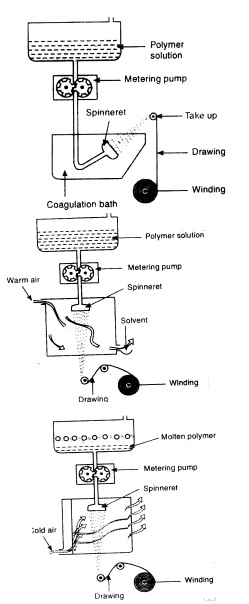Chapter: 11th 12th std standard Political Science History goverment rule laws life Higher secondary school College Notes
Rayon - Man Made Fiber : Spinning methods, Manufacturing, Properties

RAYON:
Rayon was the first fiber to be produced commercially. By the passage of time increasing number of new fibers came into existence. A generic name is the name of a family of fibers all having similar chemical composition. All man-made fiber spinning processes are based on three general steps.
Preparing a viscous solution or syrup dope.
Extruding this solution through spinneret to form a fiber.
Solidifying the fiber by coagulation, evaporation or cooling.
The raw material can be made by mixing or dissolving natural fibers with some chemicals where they are called 'regenerated fibers' or just with the mixing of the chemicals. This solution is referred to as the spinning solution or dope. 'Extrusion' is the forcing or pumping of spinning solution through spinneret holes. A spinneret is a small thimble like nozzle. Each hole in the spinneret forms one fiber. Filament fibers are fibers extruded from spinnerets which together make filament yarn. Filament Tow is an untwisted rope of thousands of fibers.
Spinning methods:
Spinning is done by three different methods in case of man-made fibers.
1. Wet Spinning:
Examples: Acrylic, Rayon, Spandex.
2. Dry Spinning:
Examples: Acetate, Acrylic, Mod-acrylic, spandex, triacetate, vinyon.
3. Melt Spinning:
Examples: Nylon, Olefin, Polyester, Saran.
After the filaments have been extruded and solidified, they are drawn out between rollers having different speeds. Drawing can also be a separate process. Spinneret size, plus spinning and drawing conditions, determine the final filament diameter. The filaments can be combined into a tow and then chopped into staple fibers. Man-made fibers may be spun into yarns, either alone or as blends with other fibers.

Rayon-Regenerated cellulosic fiber:
Rayon is a man-made cellulosic fiber in which the starting material is wood pulp or cotton linters which is physically changed. During the early history of man-made fibers, the term rayon was used to indicate any type of manufactured fiber that was based on cellulose, but now it is called man-made cellulosic fiber. Rayon received its name in 1925, before that it had been called artificial silk but because of its cellulosic content, it greatly resembles cotton in its chemical properties. Also known as viscose / polynosic.
Manufacturing Process:
By using different chemicals and manufacturing techniques, two basic types of rayon were developed. They were viscose rayon and cuprammonium rayon. Viscose rayon can have more names like standard viscose, regular viscose and high wet modulus rayon, depending on the changes made to get different qualities. Schweitzer in 1857 dissolved in an alkaline copper solution. In 1890, Despeisse developed a method to make a filament. The method was frequently modified until now it is capable of producing the finest diameter of any of the rayons.
Cotton linters afford the greatest purity and are the preferred source cellulose. These fibers are cleansed by cooking in a mild caustic alkali and bleached with chlorine.
The purified alpha-cellulose is washed, dried and treated with basic copper sulphate and ammonia.
The viscose solution is forced through spinnerets into water, which removes much of the copper and ammonia.
The filaments are passed through a mild sulfuric acid bath to coagulate them and to remove the copper.
The skeins are washed and rinsed.
The yarns are sorted according to denier.
Properties of Rayon: :
Shape : Controlled by manufacturer. Diameter varies from 12 to 40 microns.
Luster : Vary from dull to bright.
Strength : 2.4-3.0
Elongation : 19-24%
Elasticity : 82%
Density : 1.5 for all types of rayon.
Moisture : 10.7 to 16%
Dimensional stability : Poor for all types of Rayon.
Resistance to acids : Generally not good but under some conditions it is acceptable
Alkalies : Generally not good but under some conditions it is acceptable.
Sunlight : Average
Insects : Silverfish damage all types of cellulosic fibers.
To heat : Extended exposure will eventually degrade the fiber.
Related Topics